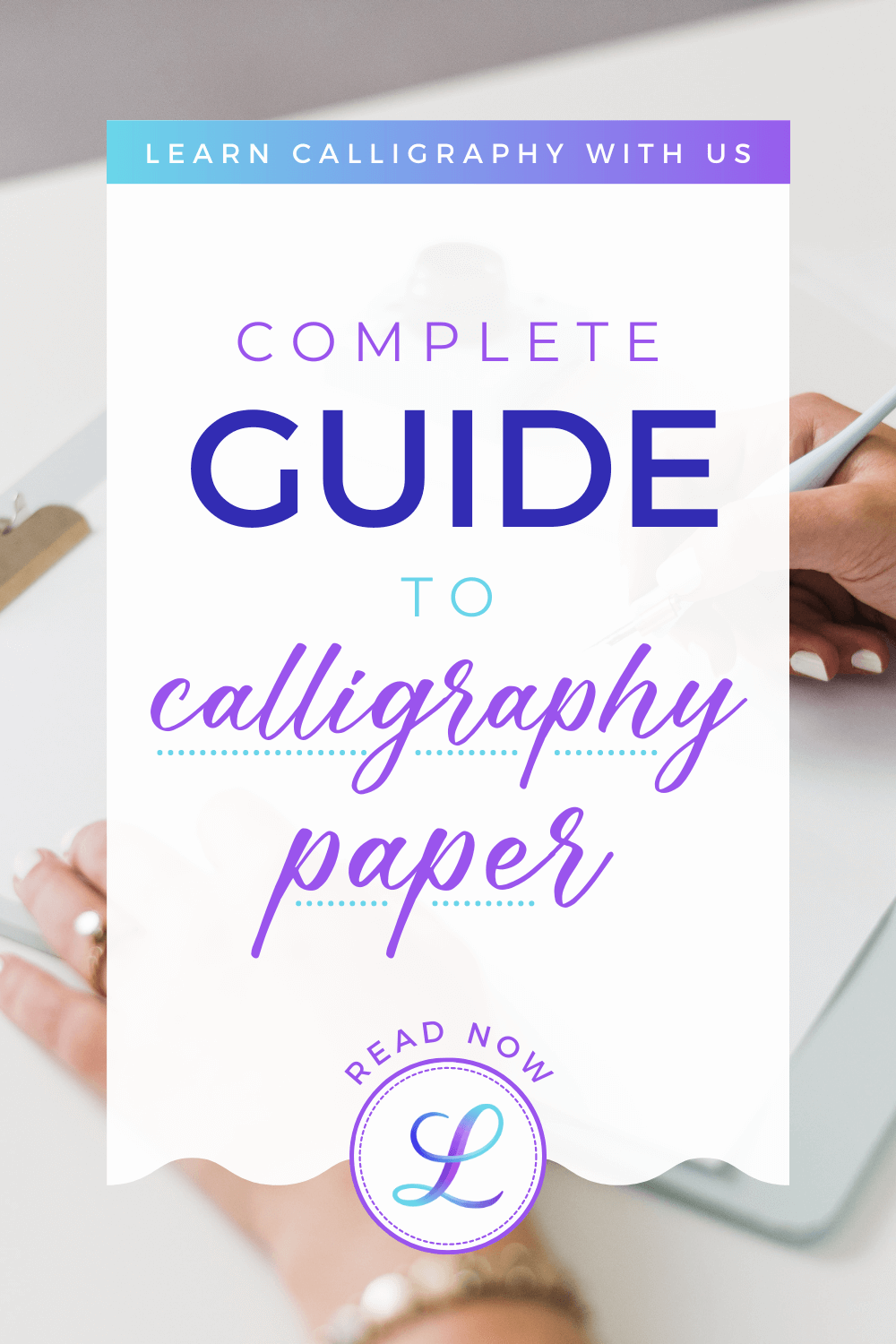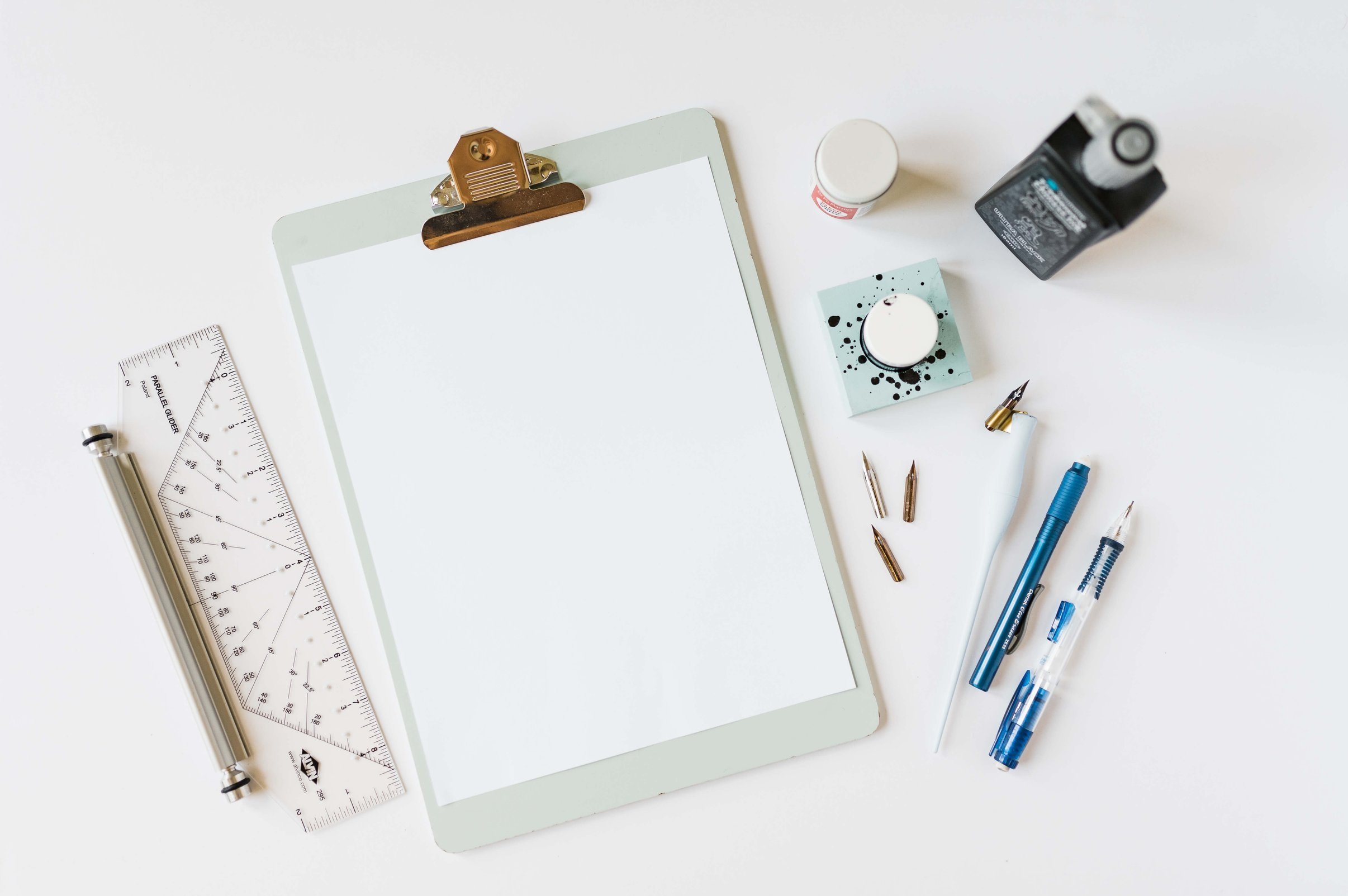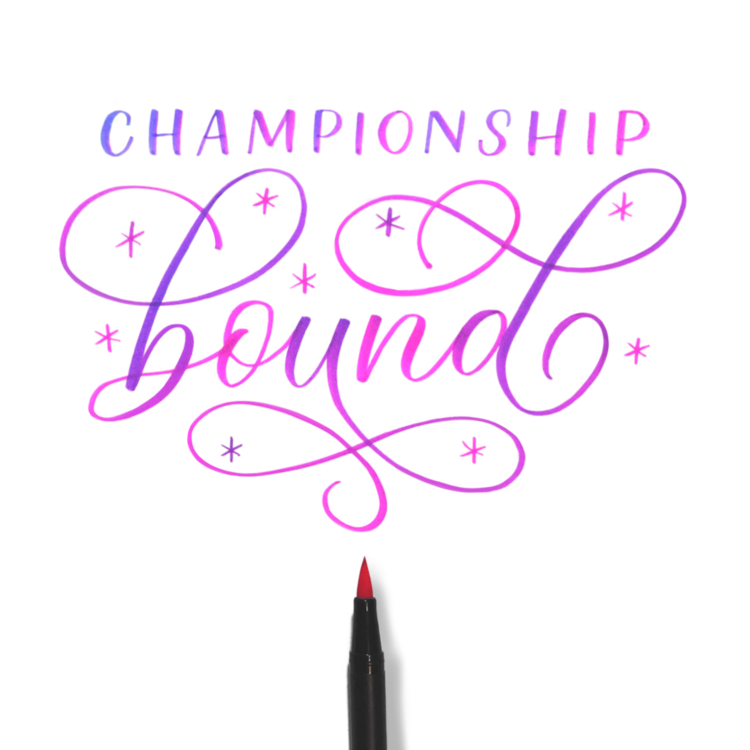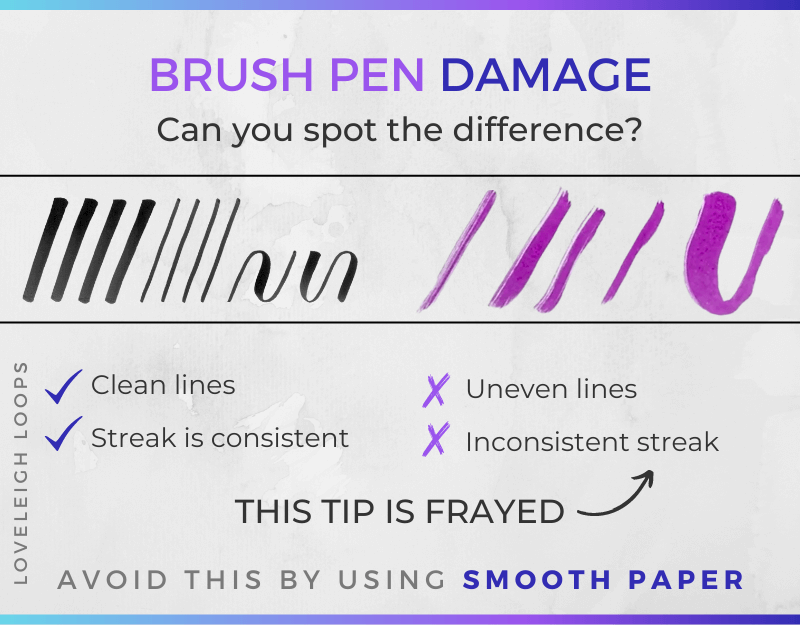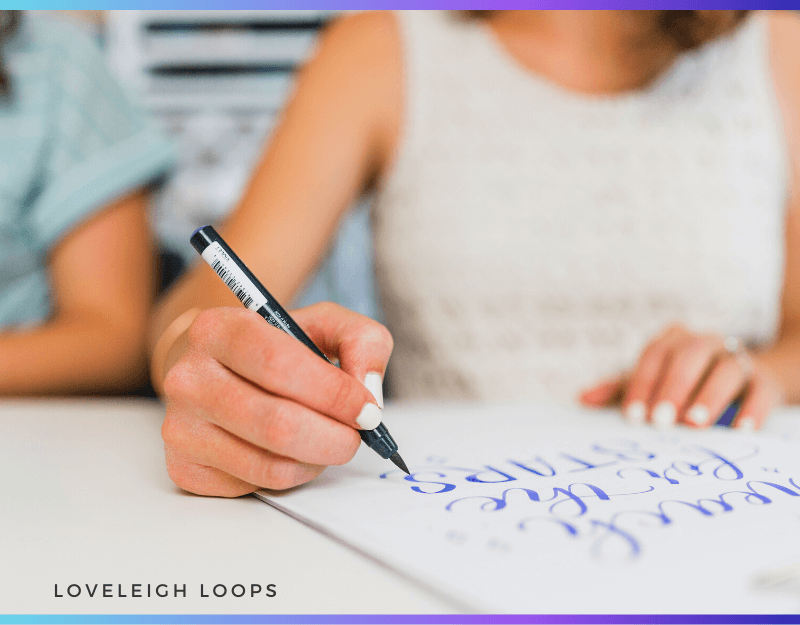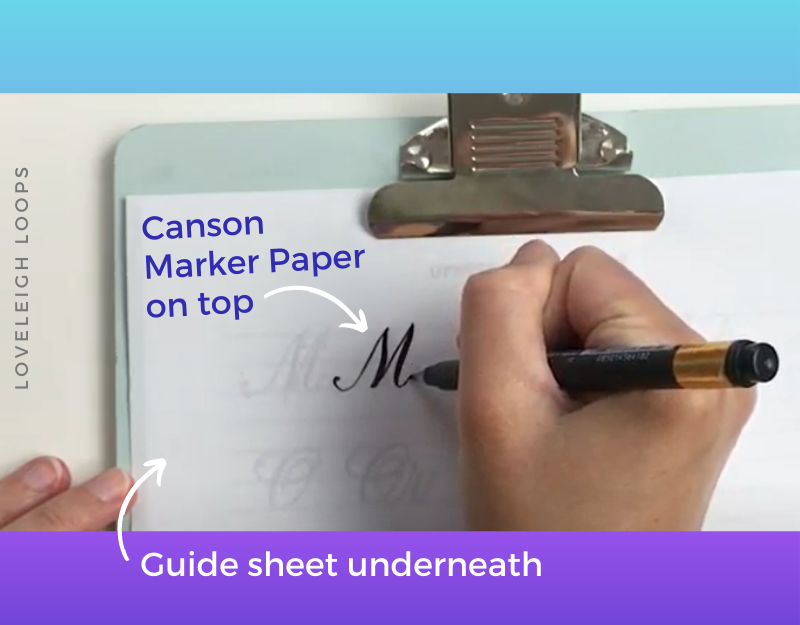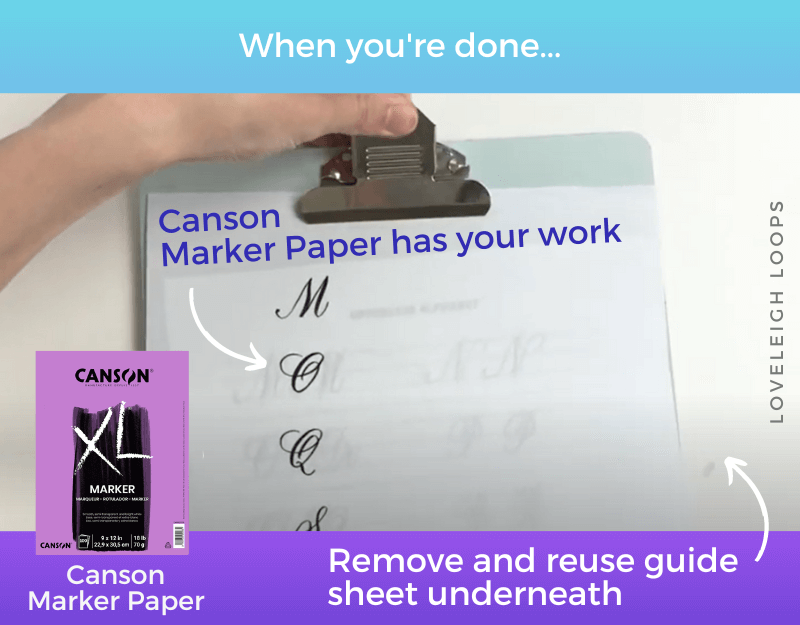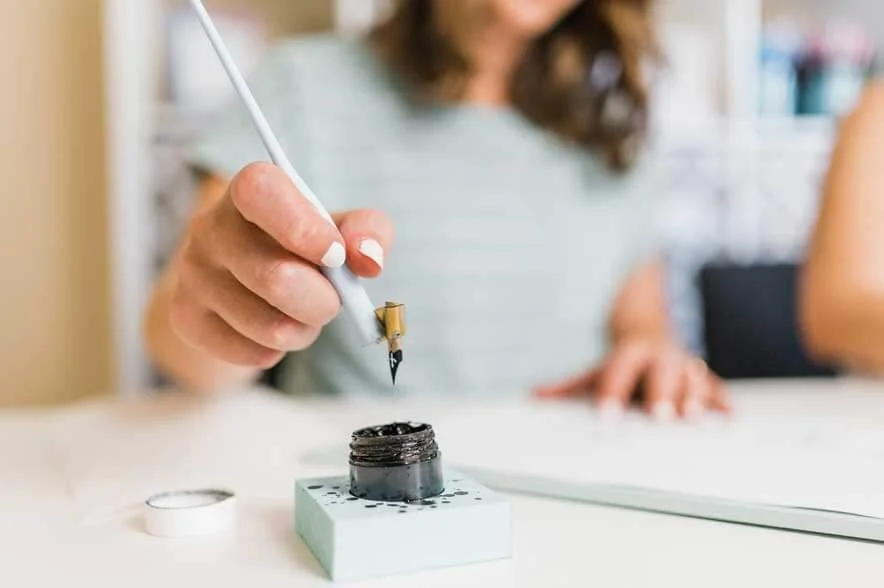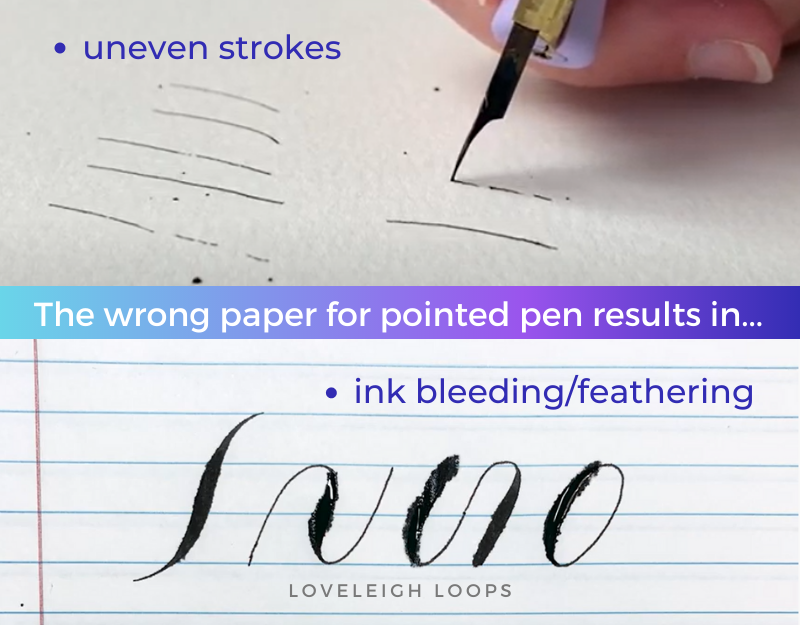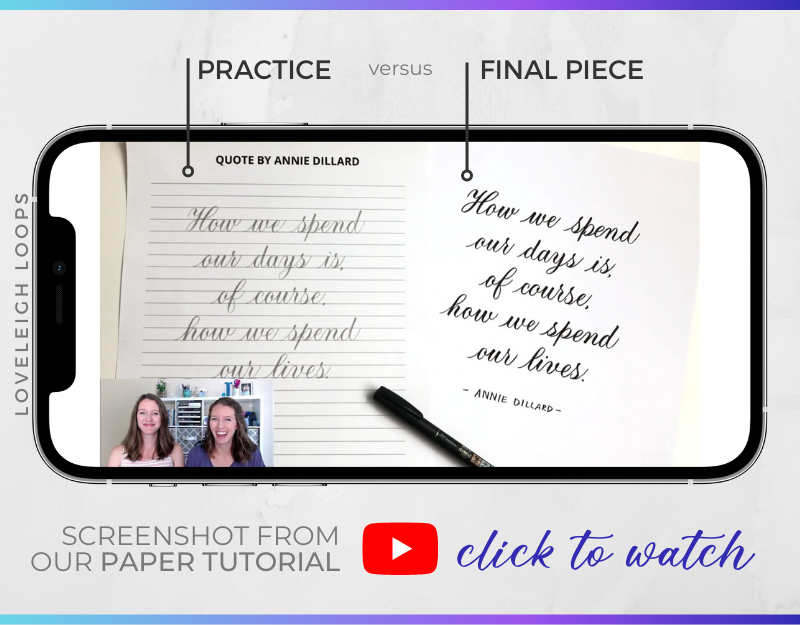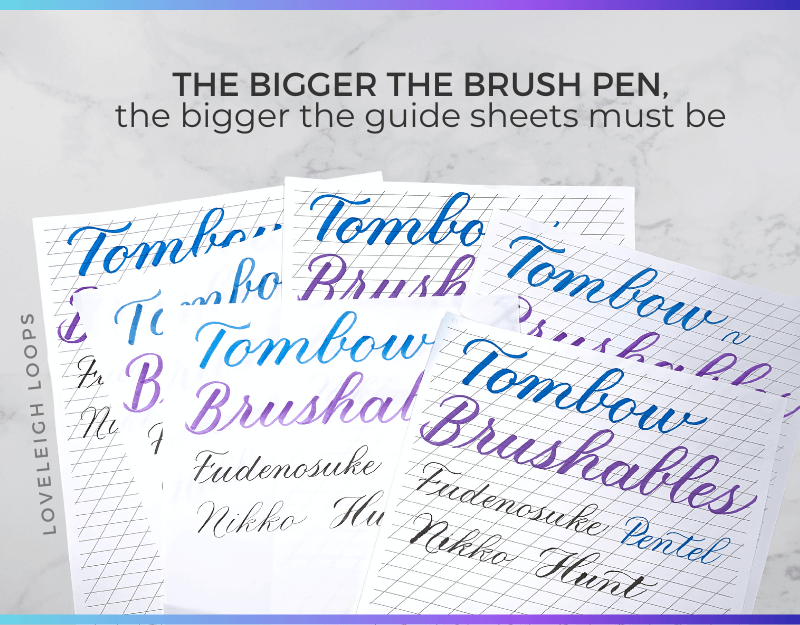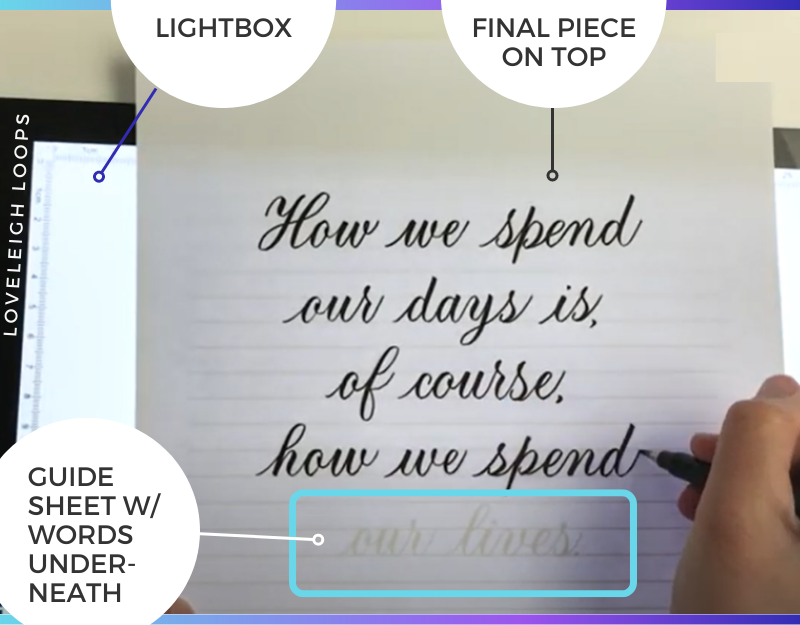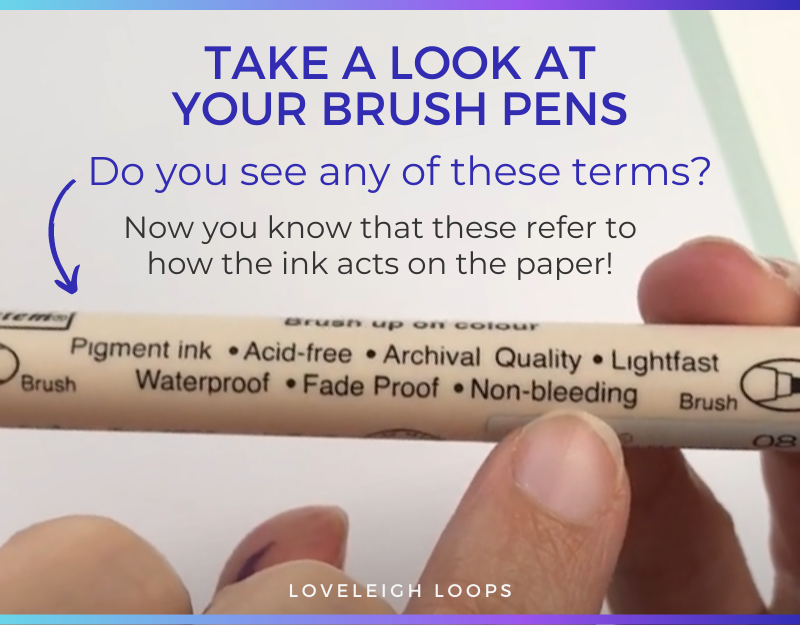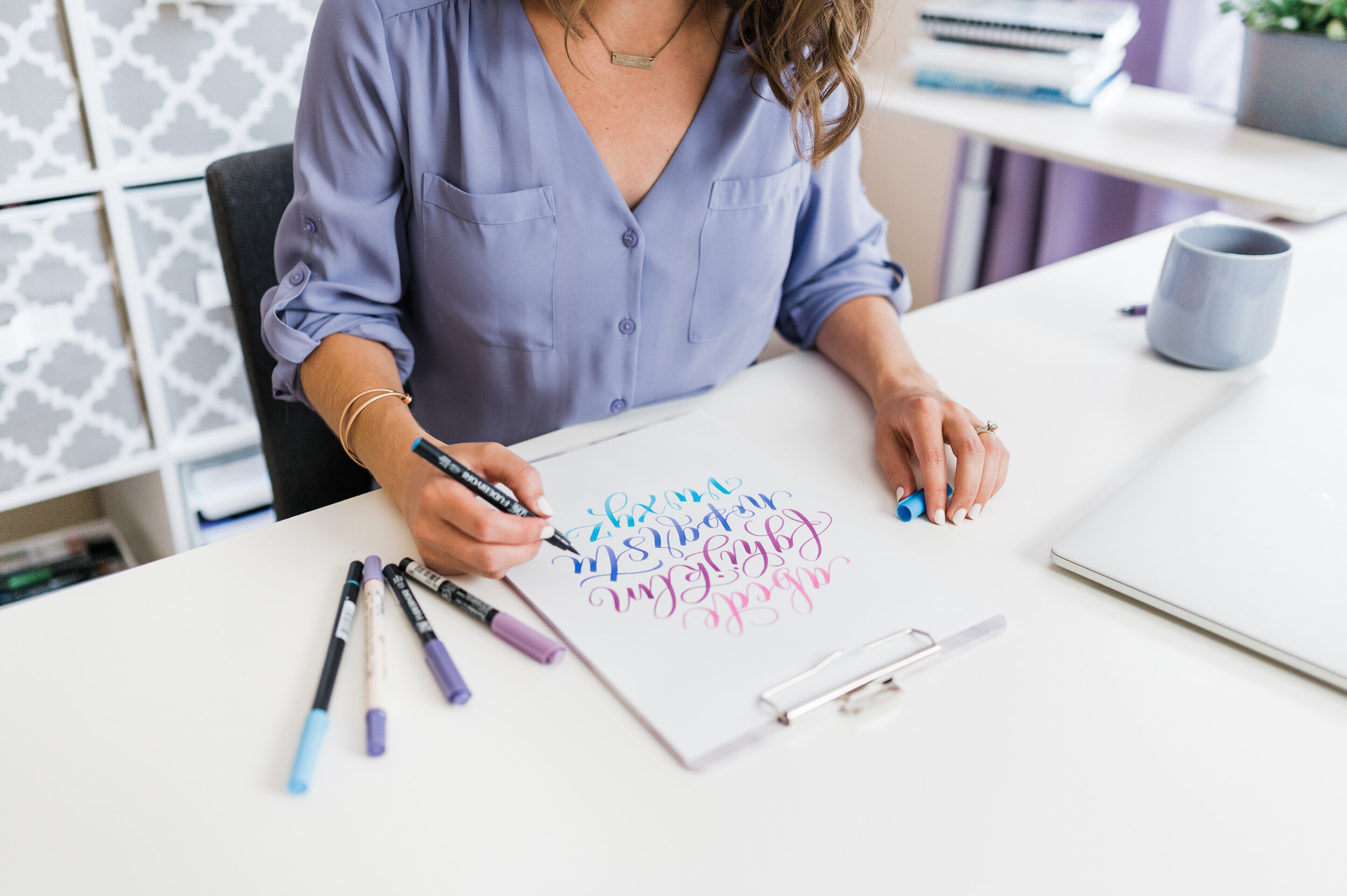Best Calligraphy Paper: Comparisons And Recommendations
With all the deliberation that comes with choosing jars of ink, holders and nibs, it may be tempting to gloss over choosing the best calligraphy paper.
Paper’s paper, right?!
Even though the average person won’t observe the quality of paper that a place card, wedding invite or diploma is printed on, paper is a wildly important part of calligraphy.
Pin it for later! ↓
Table of Contents
Choosing the right kind has the potential of elevating your end result to something polished and spectacular.
Likewise, choosing the wrong kind of paper can ruin your work and cause endless frustration.
Learning about the different types of calligraphy paper may feel tedious if you’re dying to jump right in and practice (we love your enthusiasm!!), but this step is essential for beginners in order to not get discouraged.
Prefer to watch instead? Hit play on our best calligraphy paper tutorial!
Basic knowledge of the different kinds of paper and when to use them is just as important as which pens or ink to use.
Paper comes in different varieties and not all of it is equally suitable for every style of calligraphy. In fact, which kind is best for you largely depends on the tool at hand.
Today, let’s talk about which type of paper is the…
Best paper for brush pens
Best paper for pointed pen
Right paper to practice calligraphy on
And how to choose the best calligraphy paper for finished products
Best Paper For Brush Lettering
A brush pen has a tip that almost imitates a paintbrush and an even flow of ink comes through the fibers of the tip, hence the name! It’s very popular for doing modern calligraphy.
You can tell if you have a brush pen by looking to see if your pen has a flexible tip such as this:
When you’re doing brush pen calligraphy, the most important quality to look for in paper is smoothness.
Smoothness offers a calligrapher two things:
Ease of writing
Less wear and tear on the tip of the brush pen
For the best brush pen results, you need a smooth surface so the tip of your pen glides easily across the plane. Strokes should be uniform and effortless.
You may also like: How To Hold A Brush Pen
Using rough paper doesn’t just make doing calligraphy more difficult, it also damages your writing tools. The rough surface causes the tip of your brush pen to become frayed and it becomes virtually impossible to create those smooth, crisp lines.
Pro tip: if you’ve already damaged your brush pen by using coarse paper, certain pens can flip the brush tip around to reveal another side. We show you how on Instagram.
Now that you know to choose a smooth paper, history won’t repeat itself.
If you’re thinking “my paper wasn’t THAT coarse,” you’re probably right! When it comes to the minutiae of choosing the best calligraphy paper, paper will feel smooth to the touch but have a lot more texture than meets the eye.
You may also like: How To Use A Brush Pen
Although paper may feel smooth, it might be rough at a microscopic level. You won’t feel the pain, but your poor brush pens will.
Luckily, you aren’t responsible for finding out whether the paper is smooth enough. The term smooth is a standard term in the paper industry and most papers will mention smooth as a quality on the packaging.
No need to go around the store feeling all the paper between your fingers!
A word of warning though: there is such a thing as “too much of a good thing” when it comes to surface smoothness.
Avoid terms like:
Glossy paper
Enamel paper
Slick paper
Photo paper
Those types of papers aren’t just smooth; they’re coated, and they don’t work for any ink-based calligraphy.
The finish on those types of papers makes it impossible for the ink to be absorbed, which will inevitably result in ink that never dries and will smear for all eternity (the horror!).
Our recommended paper for brush pens is Canson Marker Paper.
Why we think it’s the best calligraphy paper for brush pens because:
It’s high quality but also budget-friendly
The smooth surface is perfect for writing and kind to pens
It’s semi-transparent, which means you can use it for practicing or tracing designs
This is a glimpse at how semi-transparent paper looks in action when practicing:
Practicing with Canson Marker Paper allows you to do guided practice easily, and allows you to reuse guide sheets.
Keep reading to the practice paper section for even more ways to use paper to help you improve.
This paper comes in a 100-sheet paper pad for about $15.
You may also like: Brush Pen Comparison Guide
Best Paper For Pointed Pen Calligraphy
Next we have the pointed pen, which has even more delicate paper needs than brush pens.
Unlike brush pens which have the ink loaded into the utensil already, pointed pen calligraphy involves liquid bottles of ink and a precise metal tip (called the nib) that you dip into the ink. This makes paper selection even more important, though there is some overlap.
The best calligraphy paper for pointed pen is smooth, just like our old friend the brush pen.
Any paper that has a rough surface makes it difficult to get those consistently smooth lines you’re looking for because the nib can catch on the texture.
You may also like: Solving Common Pointed Pen Ink Issues
Smooth paper reduces the friction between the paper surface and nib, which is good for your writing as well as the nib.
Although rough paper is not likely to cause damage to your nib (it is steel after all), you may very well get shreds of paper caught in the nib, ruining your stroke.
Beyond smoothness, there’s an even more important quality when it comes to choosing the best paper for pointed pen calligraphy: absorbency.
Anyone that has ever used a fountain pen to write in a cheap college notebook is probably having flashbacks to the ink bleed!
When you use a nib that’s dipped in liquid ink, you run the risk of the ink feathering as it’s spreading out and bleeding into the page. No matter how precise and artistic your plans were, the result is very sloppy and potentially unreadable altogether.
This is why pointed pen calligraphy works best on paper that isn’t too absorbent. This automatically disqualifies paper that is too thin or too cheap.
Unfortunately, there is no real way of telling the absorbency of paper as manufacturers generally don’t list it.
Try whatever paper you have at home. The only way to find a good paper for pointed pen calligraphy is through trial and error.
…Or skip ahead since we’ve tried and tested our favorite papers already.
Our recommended paper for pointed pen is the HP Premium 32lb Paper.
Why we think it’s the best calligraphy paper for pointed pens because:
It’s both budget-friendly and high quality
The absorbency is just right for the ink
It’s smooth enough for the nib to glide and no fiber tearing of the paper itself
This paper comes in a 500-sheet ream for about $20.
We like to highlight budget-friendly paper because that means that it’s accessible to more calligraphers, but it also means that you can print calligraphy practice sheets on them without breaking the bank or reducing your practice time to save paper.
You may also like: Top Supplies for Traditional Calligraphy
Best Calligraphy Practice Paper And Tools
When you pick up your ink or your brush pens, you’re generally doing one of two things: you’re either practicing or working on a final design.
When it comes to paper choice, there are some prudent decisions to be made here.
It’s not necessary to practice on your finest paper. After all, the idea of calligraphy practice is that by working on individual elements you build the muscle memory needed to create the letters for your final design.
There’s no need to fill an entire pad of expensive paper practicing your basic calligraphy strokes.
Which, if you haven’t practiced yet, you should download your free practice worksheet here!
For all types of calligraphy practice, you should be using a worksheet with guidelines so you can work on getting that all-important consistency.
A word of warning: although there are plenty of ready-made calligraphy practice paper workbooks on the market, you shouldn’t rush to hit “add to cart.”
Here’s why: the size of your writing tool, whether it's a small brush pen, large brush pen or a nib, determines the necessary distance between the guidelines on your practice sheet.
Use caution with pre-printed workbooks because you can’t guarantee that the guide sheets will be the right size or angle. Plus, you can’t print more sheets once you’ve run out.
Calligraphy Practice Workbook
For the best results, download our Beginner Calligraphy Workbook. It comes with guide sheets of various sizes with plenty of space for you to trace and practice letters on your own.
It’s the perfect tool for practice because:
You can print it on any type of paper
This means that you can use it with any type of pen
There are $187 worth of fun bonuses
It’s an instant download (start improving *right* now)
It has a money-back guarantee, so that you can invest in your calligraphy improvement without any pause
Tracing Paper
The Canson Marker Paper we discussed earlier is semi-transparent, which makes it a great calligraphy practice paper.
Place it over your practice sheets or designs and practice away without having to worry about erasing pencil lines when you’re done.
Light Pad
When using thicker paper, a light pad is the best solution. Writing against the backlight panel enables you to see through thick paper to trace your guide sheets or final work.
And what about when your practice has led to the confidence to make your final piece? That calls for something special.
You may also like: Learn The Copperplate Uppercase Alphabet
Calligraphy Paper For A Final Piece
You worked diligently practicing your quote, place cards, or whatever work of art you’ve been perfecting! Time to pick the best calligraphy paper to make it shine.
Think of your calligraphy tools as ingredients for a recipe. You can be the best chef in the world but there’s only so much you can do without quality ingredients.
You need quality paper to make your calligraphy look good for a long time, which means:
It should be an impressive quality
It needs to age well
The ink needs to dry and absorb correctly into the fibers
Starting at the top: the first thing to look for is quality paper that’s thicker and has a higher weight than marker paper. Look at the packaging of the paper to get all the info you need!
This is the Spencerian script
Ordinary paper, like the aforementioned marker paper, is not particularly thick and weighs 18 lbs/m2 whereas high-quality paper that’s meant for a more permanent art piece weighs at least 32 lbs/m2.
Using thicker paper makes the product of your hard work look better. Not only does it add to the aesthetic of the piece (cheap paper makes your calligraphy look cheap), using thick paper allows for more creative designs.
For example, with watercolor paper and brush pens you can create this surprisingly easy watercolor background to write your design on.
Finally, using the right kind of paper can give your final piece the longevity it deserves. If you’ve ever seen a stack of old books or old newspapers, you know what we’re talking about here.
You may also like: Beginner’s Guide To Basic Calligraphy
Ordinary paper turns yellow as it ages. For a final piece, it’s well worth getting paper that says acid-free on the packaging.
This treatment prevents the paper from turning yellow and will ensure that your final piece won’t end up looking like a pirate’s treasure map!
Pro tip: Always remember to use a guard sheet when working on your final piece so the oils on your hand don’t come into contact with your paper.
Likewise, your ink needs to be preserved and specific paper quality can help. Look for the ColorLok technology logo on your paper package.
ColorLok means that the paper has an additive that locks the pigment in the surface of the page rather than being sucked into the paper and away from the surface. An added benefit is that the paper becomes less absorbent.
Check out the printer paper you have at home - you may be surprised to see that you already have this kind of paper on hand!
Pro tip: There are some special-made inks that have long-lasting qualities such as archival or lightfast can help preserve your lettering art even longer.
What About Cardstock?
This is a frequently asked question when it comes to choosing the best calligraphy paper, and we have few words of caution for you.
It seems like cardstock would make cute placeholders or wedding invitations, however the material isn’t *ideal* for calligraphy. While cardstock is nice and thick, it has a little bit of a rough surface which, as you now know, won’t do your pens any good.
If you want to use it, keeping a designated pen that you only use for cardstock prevents you from damaging your favorite writing tool.
Likewise, keep a few extra pens on hand since cardstock material tends to be more absorbent than normal paper and can go through the ink faster.
Are you always looking for an excuse to buy some more brush pens? We so get it. Here are our favorites.
Jillian doing brush pen lettering
Final Thoughts
Are your socks knocked off by how much thought goes into a simple piece of paper?!
You have our blessing to name-drop any of these fun facts about paper into your next conversation.
How’s this for another paper fun fact: people didn’t always use to write on paper! Read our article on the history of calligraphy to see what they used instead.
We hope that with this guide to the best calligraphy paper, the choices and differences are demystified and now you feel like a total pro.
If you have questions about paper, leave them on our YouTube video and we’ll see if we can help! With these few calligraphy papers that we recommended, you’ll be able to take your practice and final works of art far.
And let us help you take your calligraphy even further! We have endless tutorials, blog posts and even calligraphy courses that will take you as far as you want to go.
We want to help you learn calligraphy.
Our most popular pen and paper calligraphy courses:
Not sure which course is right for you? Send us an email at hello@loveleighloops.com and we’ll help you pick!
More calligraphy tutorials:

